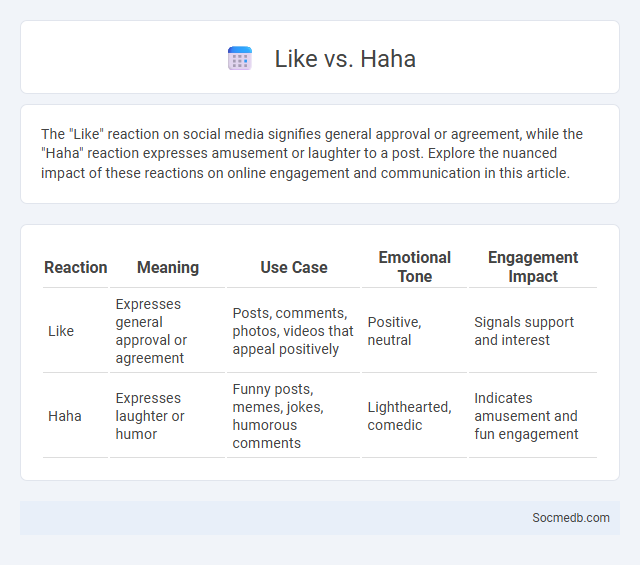
Photo illustration: Like vs Haha
The "Like" reaction on social media signifies general approval or agreement, while the "Haha" reaction expresses amusement or laughter to a post. Explore the nuanced impact of these reactions on online engagement and communication in this article.
Table of Comparison
| Reaction | Meaning | Use Case | Emotional Tone | Engagement Impact |
|---|---|---|---|---|
| Like | Expresses general approval or agreement | Posts, comments, photos, videos that appeal positively | Positive, neutral | Signals support and interest |
| Haha | Expresses laughter or humor | Funny posts, memes, jokes, humorous comments | Lighthearted, comedic | Indicates amusement and fun engagement |
Understanding Facebook Reactions: An Overview
Facebook Reactions expand user engagement by offering six distinct emotional responses: Like, Love, Haha, Wow, Sad, and Angry, allowing more nuanced interactions beyond a simple Like. These reactions provide valuable insights into audience sentiment and content performance, enabling marketers to tailor their strategies effectively. Analyzing reaction data helps identify trends in user behavior and enhances community management on the platform.
The Evolution from "Like" to Multiple Reactions
Social media platforms have transformed user engagement from the initial single "Like" button into a diverse set of reactions including Love, Haha, Wow, Sad, and Angry, enhancing emotional expression online. Facebook introduced this multi-reaction system in 2016, setting a trend followed by other platforms to capture nuanced user responses. This evolution supports richer interaction metrics, enabling brands and content creators to better analyze audience sentiment and tailor their strategies.
Emotional Nuances: What "Like" Really Means
The social media "like" functions as a complex indicator of approval, agreement, or emotional resonance, often reflecting subtle nuances beyond mere popularity. It can signal support, empathy, or shared experience, serving as a digital shorthand for emotional connection among users. Understanding the layered meanings behind "likes" reveals insights into online behavior, interpersonal dynamics, and the psychological impact of social validation in virtual communities.
Decoding the "Haha" Reaction: Humor and Sarcasm
The "Haha" reaction on social media often conveys a mix of humor and sarcasm, reflecting complex emotional nuances beyond simple laughter. Your interpretation of this reaction can influence online interactions, as it may signal genuine amusement or a subtle critique. Understanding these layers helps decode digital communication more accurately, improving social media engagement and response strategies.
The Psychology Behind Choosing a Reaction
The psychology behind choosing a reaction on social media reveals users often select responses that mirror their emotions, social identity, and desire for connection. Neuroscientific studies indicate that reactions like likes, loves, or laughter activate reward centers in the brain, reinforcing positive social feedback loops. User behavior analytics show that personalized reactions enhance perceived authenticity and strengthen online social bonds.
Social Dynamics: Impact of Reactions on Online Conversations
Social dynamics significantly shape the flow of online conversations, as social media reactions like likes, comments, and shares influence user engagement and content visibility. Your responses can trigger ripple effects, amplifying particular viewpoints or fostering community building, while negative reactions may lead to polarization or reduced participation. Understanding these patterns helps optimize communication strategies and promote healthier digital interactions.
When to Use "Like" vs. "Haha" on Posts and Comments
Choosing between "Like" and "Haha" on social media posts depends on the tone and context of the content. Use "Like" to show general appreciation or agreement, while "Haha" is appropriate for humorous or light-hearted posts and comments that genuinely make you laugh. Understanding these reactions helps convey your intended emotion effectively and enhances engagement on platforms like Facebook, Instagram, and Twitter.
Brand Engagement: Leveraging Reactions for Better Reach
Maximizing brand engagement on social media hinges on strategically leveraging reactions such as likes, comments, and shares to broaden your content's visibility and reach. Understanding the unique impact of each reaction enables your brand to tailor content that resonates deeply with your target audience, fostering stronger connections and encouraging community interaction. This approach not only amplifies organic reach but also enhances brand loyalty and long-term customer value.
Measuring Content Success: Interpreting Reaction Data
Measuring content success on social media relies heavily on interpreting reaction data such as likes, shares, comments, and engagement rates, which provide insights into audience sentiment and content effectiveness. Analyzing patterns in these metrics helps identify high-performing posts and refine content strategies to boost reach and interaction. Leveraging advanced analytics tools enables marketers to track real-time user responses and optimize future campaigns for maximum impact.
The Future of Social Media Reactions
Social media reactions are evolving beyond simple likes and emojis, incorporating AI-driven sentiment analysis and personalized engagement options that enhance user interaction. Platforms like Facebook, Instagram, and Twitter are integrating more nuanced reaction types, enabling you to express complex emotions and increase authentic connectivity. These advancements will shape how brands and users interpret feedback, fostering deeper community engagement and real-time response strategies.
 socmedb.com
socmedb.com